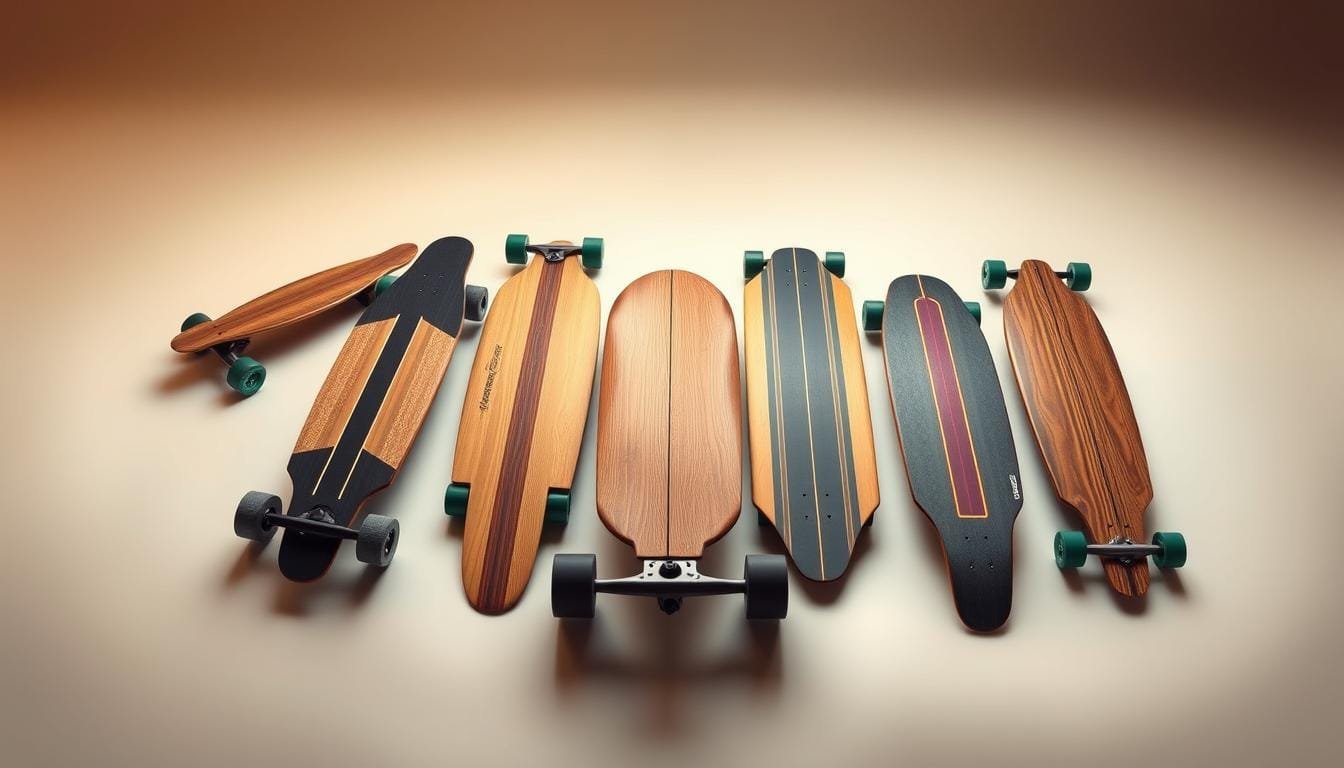When it comes to picking the right board, bigger riders often wonder: longboards or skateboards? Longboards are usually seen as the better choice for people who are larger. They have features that help with stability and balance. Is this really true? Let’s look closer to see if longboards for big riders are indeed a better fit.
Key Takeaways
- Longboards typically range from 38 to 60 inches, providing extra length for balance.
- Suitable longboards for larger body types often feature a width of at least 10 inches.
- Larger, softer wheels on longboards offer a smoother ride on rough terrain.
- Longboards with 8 or more layers of maple wood are recommended for heavier riders.
- The weight limit of top longboards for heavy riders can be up to 300 pounds.
- Harder bushings (91a to 97a+) are more appropriate for riders weighing 175-220+ pounds.
Understanding Longboards and Their Design Features
Understanding Longboards and Their Design Features
Longboards are special because they’re usually over nine feet long. This extra size helps them perform better. They come in different shapes like the California classic and the Hawaiian speed shape. These shapes have evolved since the 1950s to suit various styles and waves.
The materials in longboards, like wood or fiberglass, are key to their performance. Epoxy longboards are lighter and stronger, making them great for rough waves. Custom longboards let people choose designs that best fit their style and body.
Design features of longboards affect how they ride. The shape of the tail changes how the board moves in the water. Also, the fins help control speed and stability. New materials like carbon fiber make longboards more versatile.
When picking a longboard, think about its rocker, rails, and wheelbase. The rocker influences speed and maneuverability. The design of the rails affects how the board rides waves. And the wheelbase impacts how the board handles, especially at different speeds.
Choosing the right longboard wheels, bearings, and decks matters a lot. Decks can be soft, medium, or stiff, affecting stability and shock absorption. Beginners should use wheels with a 75a-80a durometer for better grip. Remember, keeping bearings in good condition is important for a smooth ride.
The Benefits of Longboarding for Bigger Riders
For bigger riders, longboards are a great choice due to their many advantages. One huge benefit of longboarding is more stability. Longboards are longer and wider, ranging from 38 to 60 inches by 9 to 11 inches, giving a bigger platform. This larger area boosts confidence and balance for the rider.
Another longboard advantage is in the wheels. Longboards have bigger, softer wheels. This means they can handle bumps better, making rides smoother and less tiring. Bigger riders find this leads to less body strain and a more fun cruising experience.
Deck designs also add to the benefits of longboarding. Longboards often feature concave and drop-through decks. These make the board more stable and easier to control, which is vital for heavier riders. They also help avoid wheelbite when going fast, making riding safer.
Longboarding isn’t just more comfortable and stable; it also offers a variety of riding styles. Bigger riders can try carving, downhill sliding, noseriding, and hand-paddling. With different styles, longboards cater to personal interests and skill levels. This versatility is why it’s a top choice for many.
Longboard trucks also bring more ease with reverse kingpin (RKP) technology. These trucks are wider, coming in sizes like 150mm or 180mm. They make the board more maneuverable and stable. For decks wider than 9 inches, 180mm trucks are best, providing even more control and stability for bigger riders.
In the end, the benefits of longboarding for bigger riders are found in its design and adaptability. With features focused on comfort, stability, and flexibility, longboards are a smart pick. They ensure a safe and enjoyable experience on the skateboard.
Choosing the Right Longboard for Your Size
Finding the right longboard for your body size makes a big difference. A good size guide helps you understand which longboard is best for you. Let’s look at what you should consider.
Board length matters a lot. It should match your height, weight, and skating plans. Here’s a summary to help you:
| Rider Category | Recommended Board Length |
|---|---|
| Children / Smaller Teenagers | 25-29.5 inches |
| Women / Smaller Adults / Lighter Adults | 29.5-33 inches |
| Large Adults / Heavier Adults (Cruiser Skateboards) | 29.5-33 inches |
| Large Adults / Heavier Adults (Longboard Cruisers) | 33-36 inches |
| Technical Dancing / Longboard Freestyle | 40-60 inches |
| Freeride / Downhill | 33-36 inches |
| Transition / Bowl Skating | 30-32 inches |
Longboard width also affects how well you steer. Smaller feet? Go for narrower decks. Measure your foot and subtract 1.5 to 2 inches to find a good width.
Cruising and commuting boards vary in size. Shorter ones work well for close-by places. Longer boards are best for far distances. Dance and boardwalk lovers need boards longer than 45 inches.
For freeride and downhill, you want a board that’s stable at fast speeds. A long wheelbase helps with stability. A shorter wheelbase makes a board quick and sharp.
In skateparks, wider boards (9 inches or more) are your friend. Longer boards are heavy but stable and great for beginners. While shorter boards are light and easy to move, perfect for advanced riders.
Choosing a longboard is about finding the right balance. Use a dependable size guide to find what works for your skating style.
Comparisons with Other Types of Skateboards
When we look at longboard vs skateboard, we see differences in size, wheels, and deck flexibility. Longboards are longer, ranging from 28 to 59 inches, compared to skateboards, which are about 36 inches. These differences affect how they are used and who enjoys them the most.
Skateboard wheels are smaller, between 52mm and 58mm, while longboard wheels measure between 63mm and 80mm. The bigger wheels on longboards make for a smoother ride. This is especially noticeable when you’re going for long distances.
The wheels on skateboards are harder, suited for tricks and stunts. Longboards have softer wheels, focusing on comfort and smooth control. Longboard trucks also add stability at high speeds, unlike skateboard trucks that are made for tight turns.
Longboards have flexible decks that help in absorbing shocks. This flexibility is great for long rides. It’s also helpful for bigger riders who need more comfort and support.
Longboards fit styles like cruising, downhill, and dancing. On the other hand, skateboards are best for street tricks and bowl riding. Beginners find longboarding easier to learn, while skateboarding requires more practice.
Longboards need less upkeep, costing less over time. They are also seen as safer, with fewer injuries reported compared to skateboarding.
Cruiser boards offer a mix of portability and ease, perfect for short travels. Mini cruisers go a step further, being very portable. They are great for beginners and kids thanks to their small size and simplicity.
| Type | Ideal Use | Size | Wheel Size | Flexibility | Learning Curve |
|---|---|---|---|---|---|
| Longboard | Cruising, Downhill, Freeriding | 28-59 inches | 63-80mm | High | Gentle |
| Skateboard | Tricks, Street, Vert | 36 inches | 52-58mm | Low | Steep |
| Cruiser Board | Commuting, Short Distance | 19-31 inches | 55-65mm | Medium | Moderate |
Knowing the differences in skateboards helps you choose what’s best for you. For those needing a comfortable long ride, longboards with their bigger size and wheels, and softer decks are the way to go.
Tips for Riding Longboards Safely
Ensuring your safety on a longboard is key, especially for those who are heavier. By following key safety tips, you can have fun longboarding without facing risks. Let’s look at how you can longboard safely and enjoy every moment.
Choosing the correct board that can support your weight is crucial. Go for trusted brands like Sector 9, Sanford Shapes, and Landyachtz. They make longboards that are stable and perform well, which keeps you safe while riding.
The value of protective gear can’t be stressed enough. Wearing a helmet, for instance, can cut the chance of head injuries by 85%. Elbow and knee pads can also lower injury severity by 60% for newbies. Don’t skip out on quality safety gear—it’s a key part of staying safe.
Beginners should start on flat, smooth surfaces. This builds confidence and skill. Roughly 50% of longboard injuries happen while going downhill. It shows how crucial it is to get comfortable on easier surfaces first.
Being aware of what’s around you is also key. About 30% of longboarders listen to music while riding. This increases accident risks by lowering awareness. Paying attention can stop many accidents, especially in busy city areas.
Riding with a friend is popular for safety. A survey found that 65% of longboarders do this. It’s safer and builds a sense of community among riders.
Following traffic rules is really important, too. Sadly, only 20% of longboarders always do this. Sticking to these laws can reduce accidents and keep your rides safe.
By using these longboarding safety tips carefully, you can enjoy longboarding with less risk. Safe longboarding starts with the right gear, good safety habits, and smart riding.
Real-Life Experiences and Testimonials
For anyone new to longboarding, real skater stories are invaluable. They provide knowledge and motivation. The pandemic saw many, including the author, finding peace in skateboarding, trying freeride and downhill. Moving from traditional skateboards to longboards brought new joy, thanks to their stable and unique designs. For a deeper understanding, read their story here.
Joe, who weighs 220 lbs and is 5’9″, explored longboarding when times were tough. He found it mentally and physically rewarding. The wider decks of longboards helped his balance. Joe’s experience is like many others’, finding comfort in the extra space and support longboards offer.
Judith also shared her journey, worried about weight and size at first. She considered durable boards like the Blackfin Model X and Hydrus Joyride XL, supporting up to 450 and 400 lbs, respectively. Her and Joe’s findings show how the right longboard changes the game in terms of comfort and performance.
These stories are more than just advice; they build a supportive longboarding community. They show the health benefits and the joy this sport brings, making no one feel alone. Longboarding is a path to personal growth and connecting with others. Want more? There’s plenty of skater stories and tips online for inspiration.

I’m John Peterson, a passionate skater, blogger, and lifelong enthusiast. I’ve been skating for over 9 years and have gone on to write a blog dedicated to the sport of skating and its culture. Through my blog, I strive to share my knowledge and experience of the sport with all who are interested. From beginner tips, tricks, and equipment reviews to interviews and event coverage, I cover it all. So read my blog as I explore the wonderful world of skating!

